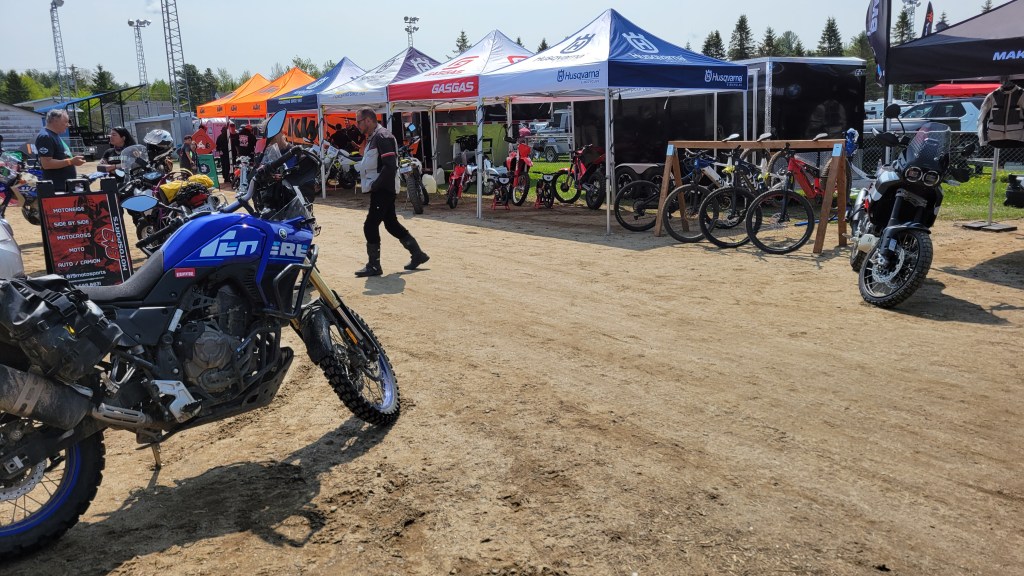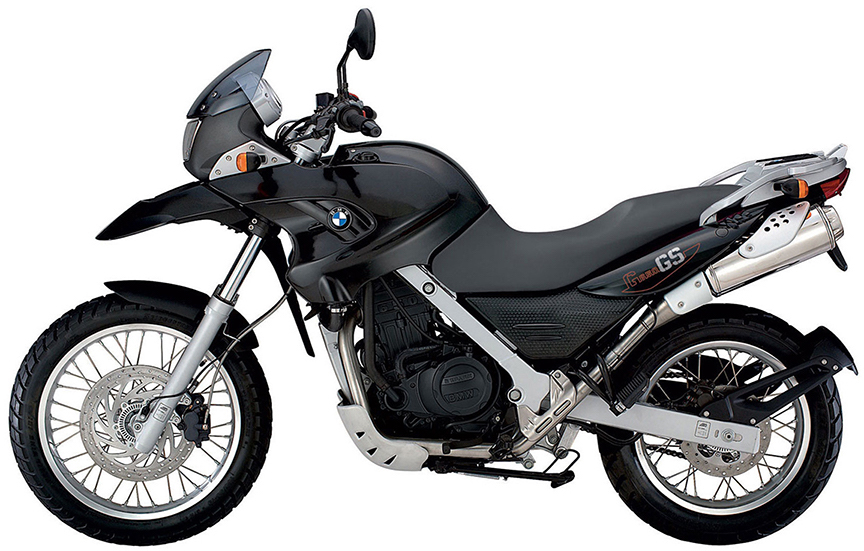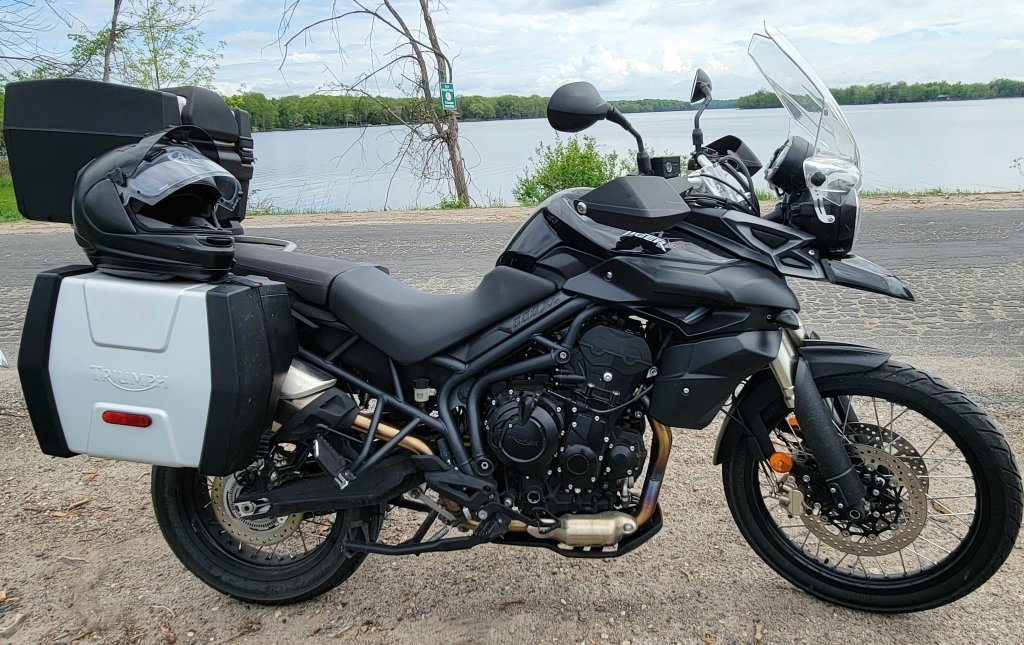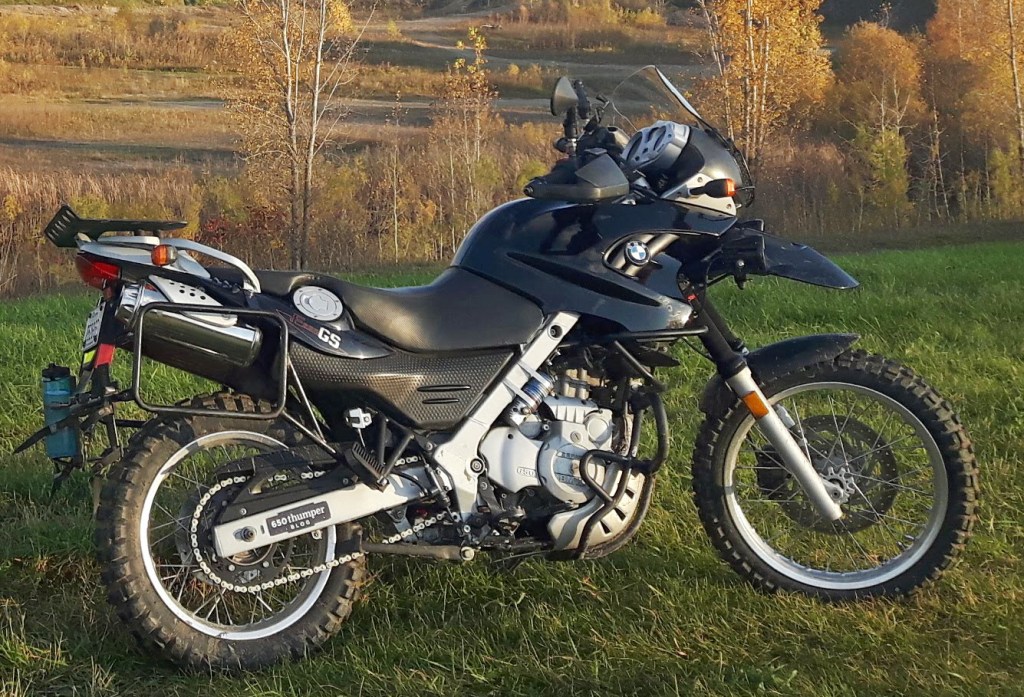If you like dual sport riding, you’ll love La Classique.

La Classique, organized by RidAventure.ca and with close to 1000 riders, is the largest dual sport rally in Canada. It’s so popular that I’d never managed to get in. Registration fills in about 2 days—you blink and you miss it—and always seems to fall when I’m busiest at work grading mid-terms. I almost missed it again this year but snuck onto a team last minute.
It used to be you had to organize a team, and I could never find riders willing to join me. Now RidAventure has simplified the process and you can register as a single rider and join an existing team. That’s what I did and found myself on Les Amis de la Motorcyclette, a great group of Francophone guys. RidAventure has also separated the Saturday and Sunday rides to allow wider participation in the event. That’s a great idea because even if you aren’t riding, there are vendors and test rides available for a more relaxed day of hanging about.
I registered for the Saturday Classique Plus route, which is about in the middle of the skill level of rides. You have to be comfortable riding Level 2 Trails. I felt pretty good about that but was a little concerned about my tires. Organizers are clear that you need knobbies for anything Classique Plus and up, and because of the long-distance touring I’m doing this summer, I had on Dunlop Trailmax Mission tires, a street-biased 70/30 tire. In the end, I probably should have had a more aggressive tire, but I managed.
This rally falls nicely for me right at the end of the school year. I worked hard in the weeks prior to the rally, pushing to complete all my end-of-term grading so I could ride away with a clean conscience. In fact, I did so much intensive grading toward the end that I developed a mild case of carpal tunnel syndrome in my writing hand. Thankfully, it didn’t significantly affect my use of the throttle and front brake except in the most intensive sections.
Parts arrived from Dual Sport Plus just in time, and I spent the Friday of my departure adding hand guards and folding mirrors; I was worried about breaking a lever or a mirror in a crash, which is not uncommon in dirt riding. I was also worried about breaking my bones so geared up in my Knox Adventure Shirt, neck guard, and tucked some wrist braces into my bag. (Yeah, a little tip-over can cost you the better part of the season, so I’ve started using these if there is a chance of falling.) I left unfortunately at rush hour on a Friday, so after the requisite hour to get off the island, I was on my way.
One nice thing about these rallies is that you can camp on site. The rally this year was in a new location in Saint-André-Avellin, north of Montebello, and there was a big open field for all the tents. RVs were parked in another area, and there were a lot of them!

Now if there’s one thing I know about camping in Canada, it’s that you don’t want to do it before July. The bugs are bad! In my last minute haste, I forgot to pack bug spray (doh!), so the first order of business once I got my tent pitched was to find some. Then I checked in at registration, got my sticker and T-shirt, and spent the rest of the evening hanging with The Awesome Players at their camp. As you may remember, I did a few rides with them a while back, and they are a great bunch of welcoming guys. In fact, although I was on my own for the weekend, I never felt alone; there’s a strong sense of fellowship within the RidAventure community.
One of the things I like about these rallies is checking out all the bikes. The next morning, before forming up for my ride, I took a stroll along where the campers’ bikes were parked.
Yes, that is an action camera I’m using. As I pondered in a previous post, I’ve decided to join the crowd of YouTube content creators, although I’m not a hero—as in, I didn’t get a GoPro. After much research, and heavily influenced by this video review by Dork in the Road of several action cameras, I decided to get an Insta360 One RS. I’m not interested in the 360 lens; I think that’s a gimmick that will quickly lose its appeal, and I don’t like how it makes every shot look unnatural, like through a fish-eye lens.
I got just the 4K boost lens and will be incorporating some short video footage into my posts in the future. I’m not interested in “competing” with full-on YouTube channels because that’s not my genre: I’m primarily a writer, not a videographer. I wouldn’t know my way around a massive video editing program like Final Cut Pro or Adobe Premiere, and I wouldn’t want the interruption in my rides of setting up a tripod for a ride-by shot or sending up a drone, although drones capture some amazing footage. So my footage will be minimal and serve to complement the written accounts of my rides. Anyway, we’ll start with that and see how it goes. All the videos I use will be available separately on my YouTube channel. Let me know in the comment section what you think of the new multi-media format.
Enough about that. After perusing the bikes, I had to get up to the start area and introduce myself to my adoptive team.

The rally is extremely well organized. At registration check-in, your bike is inspected, you sign a waiver, then receive a wrist band and a sticker for your bike. The sticker indicates what group you are in, and there is a corresponding marker to line up with your group. Here we all are, lined-up and waiting for the signal to pull out.
I was a little nervous, being my first Classique and not knowing if I’d chosen the right level. You don’t want it boring, but then you also don’t want to slow the other boys down. In the end, it was the right choice, but I faced some challenging sections. My philosophy in riding and in life is that you want to push yourself slightly out of your comfort zone once in a while; that’s when growth occurs. My French and my off-roading skills got an injection this weekend.
Finally we got the signal to start our engines and pull out. We were on our way.
Right away you can tell that my bike is different from most other dual sports. You can hear the high-pitched induction whine of the Triumph triple instead of the growl of a parallel twin. But that’s what I love about this bike: it’s a sport bike engine shoe-horned into an adventure chassis. It’s smooth with a ton of torque and loves to be revved, and it handles through the twisties like a sport bike. Okay, it doesn’t have the tractor factor of a big thumper or a parallel twin, and that’s something I have to keep in mind when off-roading. I have to remember to keep the revs up or it will stall climbing hills or working through sand and mud.
Soon we left the asphalt and were enjoying the countryside on some easy dirt roads. No doubt the route planners considered this as warm-up for what was to come. The trees closed in and then we were snaking through the forest on a twisty dirt road, and lacking knobbies, I had to remember to weight the outside peg on each corner or risk low-siding.
Sorry about the wind noise. This was my first time using the camera and I’ve since discovered the audio setting for wind noise reduction. There’s an option in the Insta360 Studio application for post production noise reduction, but for some reason, this particular noise gets “reduced” to a sound similar to fingernails being dragged down a chalkboard.
Soon we turned off this road and entered Parc Papineau-Labelle, and that’s when things became a little more “interesting.” Our entrance was a rocky hill climb, and although it wasn’t super difficult, as anyone with a GoPro knows, the action cameras flatten out all hills and the image stabilization smoothens out the ride. In fact, my suspension was working hard, and it wasn’t long before the ABS on my bike sent an error code to the ECU.
To sit or stand? There’s an excellent podcast by Adventure Rider Radio (April 15, 2022) with an aerospace physicist and Chris Birch on this topic—well worth a listen—but one thing I remember from it is the simple maxim to sit when you can and stand when you have to. Some terrain requires that you stand so you can control the bike through the footpegs, but standing all day would be tiring, so sit when you can. You can see me stand when I enter a climb or a sharp corner. You can also see me glance down a few times to check what gear I’m in. Sometimes I’m concentrating so much on the terrain I forget and want to verify.
This was fairly easy dirt riding so I decided to keep my ABS on. I thought you really only have to turn it off if you’re doing steep descents in loose terrain where you might find yourself suddenly without brakes. But one thing I learned this weekend is that my bike is not happy with ABS on in even this degree of chatter. You can see in the following clip that I have a couple of warning lights on. They would turn out to be the check engine and ABS lights, so I put two and two together and figured it was an ABS/speed sensor error. (Later back home, I confirmed this using an OBDII scanner.) I got pretty good at navigating through the set-up menu on my dash to turn ABS off since it resets every time I turn off the bike. For short stops, however, I was able to use the kill switch but keep the ignition on and it didn’t reset.
At one point, we came across a moose. I could see something running up ahead in the road and thought at first it was a horse, but soon realized it was a moose. We backed off and let it run ahead until it could get off the road. In all my years of canoe camping, I’ve actually never seen one, so this was exciting.
Also exciting were the patches of sand that sent the bike snaking. You just gotta hold your nerve and let the bike sort itself out. Nobody went down that I’m aware of, although there were some close calls. Here, I’m watching the guy in front almost lose it on a sandy corner, and then when I reach up to turn off my camera (I had it on loop mode), my front slides out and I almost lose it.
Finally, with the ABS turned off and a few hours of this, by lunchtime I was feeling more confident in the sand.
Unfortunately, that would be the final clip of the day. For some reason which I would only discover at lunch, my camera would not turn on and would not record anymore. When I could finally unmount the camera and have a look, it was displaying a message that an error had occurred in my last video and would I like to fix it. (I did but the above clip is missing metadata.) It had started to rain hard and I was feeling a bit stressed about keeping up and decided that perhaps this was not the best time to test and troubleshoot the new camera so I put it away. That’s unfortunate, in retrospect, because the real fun was about to begin.
Shortly after lunch we had a sandy hill to climb, and even the best riders in the group were having a hard time with it. This is where I really needed some knobbies. I was looking at the hill and thinking this isn’t going to go well, but what choice did I have? Go back to camp or go for it. So I went for it and surprised myself. It wasn’t pretty—I had to dab several times—but I got most of the way up. Having done the hard bit, the last part I did less well. Like I said, I have to keep the revs up on this bike or it will stall. But with some pushing from others, we all made it to the top and lived to ride the rest of the route.

There were some easy water crossings but no other major obstacles and we were back at camp by 5, in time to clean up before dinner.
The next day I was going to head home early but decided to do some test rides. First up, just out of curiosity, was the new Harley Davidson Pan America. It was, shall I say, a little underwhelming. If you imagine what a Harley adventure bike might be, that’s pretty much it: a little loud and rough and brash. There was a lot of vibration up through the handlebars, which was surprising because they had street shoes on. The best part of the test ride was that the sun finally came out! It had rained hard through the afternoon and night and everything was soaked, so it was nice to see the sun and to know my tent would dry out before I had to pack it up.
There’s definitely some interesting technology built into this bike. The suspension lowering feature when you stop is innovative and will open up the adventure market to those who struggle with the seat height of most adventure bikes. And hydraulic valves sound neat. I don’t know exactly how they work but the bottom line is apparently you never have to adjust the valves. There were some Pan America bikes at the rally so they are selling, but I don’t think this bike is going to cause a major splash like the Teneré 700 did or the BMW GS.
Speaking of the GS, I’ve always wanted to try the iconic bike. As followers of this blog will know, I had the single 650GS for years and loved it and always wondered what the big boxer would be like. Many said that the big cross-Canada trip I did would normally be done on the big bike, and I have to admit considering it when I decided to change my bike, but I’m nervous about taking a big bike like that off road into remote areas. It’s close to 600 lbs. and, with gear, that’s a lot to lift on your own if you dump it.
Anyway, this was my chance and so I did a test ride on a 1250GS. I have to admit, what everyone says about how it carries its weight is true. You can turn this bike easily at slow speed. But what I found most impressive—not exclusive to the GS—were the rider modes. I’ve never ridden a bike with rider modes before, and after 20 minutes in Enduro Pro mode, I was sliding this baby around corners. You can hear me making exclamations into my helmet.
It’s very confidence-inspiring, but I couldn’t help thinking that I was cheating; it wasn’t me doing the powerslides but a computer. Call me a purist, call me a technophobe, call me a Luddite, or just call me poor, but I’m glad my 2013 bike doesn’t have rider modes. I know they’re the way of the future, but for now, I’m happy to have to learn throttle and clutch control and braking using manual inputs. Speaking of which, my throttle/clutch control sucks (!) and I’ll be targeting it with some practice in the coming weeks.
Upon reflecting on my ride of the day before, perhaps what I am most proud of is not that I kept up on the tires I had, but that I did it without any rider aids, including ABS. It was all me. I’m not a great rider, not yet anyway, but if I had a bike with that level of computer input, I wonder if I’d ever be. What are your feelings about rider modes? Greatest safety advancement in motorcycle technology in the recent past, or making us all lazy, unskilled riders?
Finally it was time to start heading home. I packed up and headed down the 321 to the lovely 418 East that took me into Grenville.
It had been a great weekend at my first Classique. The sun was out and I had the whole summer vacation ahead of me. I was feeling pretty bouyant, and since I was in an indulgent mood, there was only one more thing to do to make the moment perfect.








